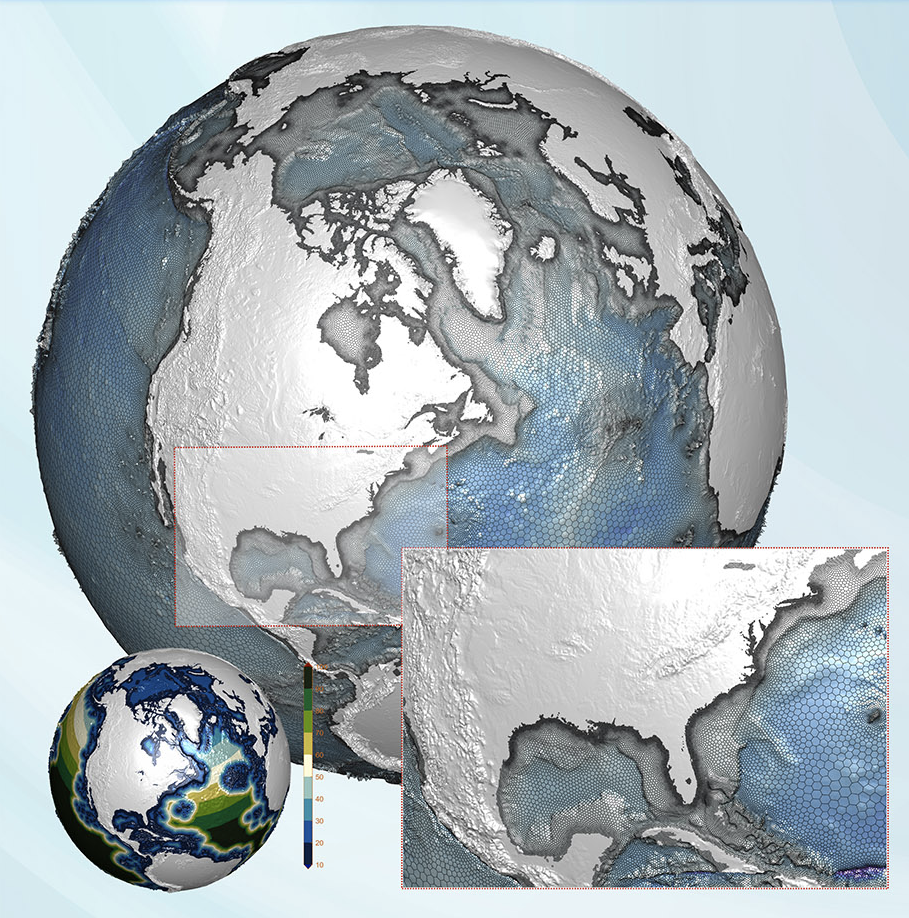Sea-Ice Dynamics on Unstructured Voronoi Meshes in MPAS-Seaice

Sea ice, North-West Spitsbergen National Park, Svalbard. This photo has been graciously provided to be used in the GRID-Arendal resources library by Peter Prokosch (http://www.grida.no/resources/3643 )
The Science
Sea ice is an important component of the Earth’s climate system, and numerical modeling of sea-ice dynamics and thermodynamics is needed to understand global climate. One of the popular sea-ice models, CICE (Hunke et al., 2015), uses a quadrilateral structured mesh. Recently, the sea-ice dynamics formulation of CICE were adapted from the regular structured quadrilateral mesh to the unstructured meshes used by the Model for Prediction Across Scales (Fig 1.) and the Energy Exascale Earth System Model (E3SM). Unstructured mesh climate models have been gaining popularity as they have the ability to concentrate their model degrees of freedom in regions of interest, improving computational efficiency, while avoiding the difficulties of open boundary conditions in limited-domain regional models.

Figure 1. Unstructured Voronoi tessellation meshes are used by the Model for Prediction Across Scales framework. (Artwork from the poster that won E3SM Best Poster Award. See also the 2019 E3SM Best Poster Award for more info on MPAS mesh.)
The Impact
The unstructured Voronoi tessellation formulation of sea ice dynamics (Turner, 2022) allows model resolution to be focused on regions of interest allowing higher resolution simulations to be performed in these regions.
Summary
A sea ice dynamical core that uses the variational formulation of the spatial operators employed in the CICE model was adapted for the polygonal grid cells found in the Model for Prediction Across Scales (MPAS) meshes. This sea ice dynamical core is used in MPAS-Seaice, which is the sea ice component of the Energy Exascale Earth System Model (E3SM). The use of the MPAS mesh, with its Voronoi tessellated cells, allows model resolution to be focused on areas of interest and/or small physical length scales, increasing the model resolution achievable for a given amount of computational resources. The MPAS mesh also allows the removal of equatorial grid cells, where sea ice does not form, increasing computational efficiency and load balancing, while also being flexible enough to allow quadrilateral meshes to still be used. The new dynamical core was validated with a series of idealized test cases examining the error convergence of the spatial operators with increasing resolution. Researchers have used global simulations with realistic forcing to validate MPAS-Seaice against CICE and observations (Fig 2.). They found very similar results compared to CICE, with differences explained by minor differences in implementation such as with interpolation between the primary and dual meshes at coastlines. MPAS-Seaice is the current sea-ice component of the E3SM.

Figure 2. Comparison of sea ice extent for Northern Hemisphere (NH) (top row) and Southern Hemisphere (SH) (middle row), and NH sea ice volume (bottom row) from MPAS-Seaice (left column), CICE (middle column), and satellite observation SSMI and assimilated data PIOMAS (right column) showing good agreement.
Publication
- Turner, Adrian K., William H. Lipscomb, Elizabeth C. Hunke, Douglas W. Jacobsen, Nicole Jeffery, Darren Engwirda, Todd D. Ringler, and Jonathan D. Wolfe. 2022. “Mpas-Seaice (V1.0.0): Sea-Ice Dynamics On Unstructured Voronoi Meshes”. Geoscientific Model Development 15 (9). Copernicus GmbH: 3721-3751. doi:10.5194/gmd-15-3721-2022.
Funding
- This work was supported by the Earth System Model Development program area of the Department of Energy, Office of Science, Biological and Environmental Research program.
Contact
- Adrian K. Turner, Los Alamos National Laboratory
Reference
- MPAS mesh details: E3SM Best Poster Award, and 2019 E3SM Best Poster Award
This article is a part of the E3SM “Floating Points” Newsletter, to read the full Newsletter check:


